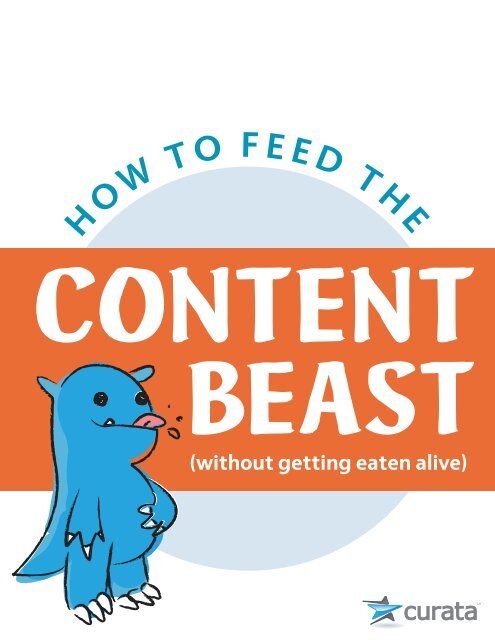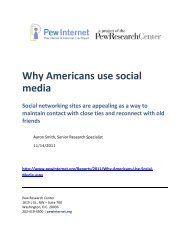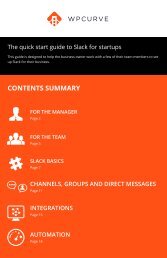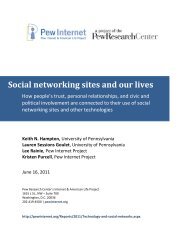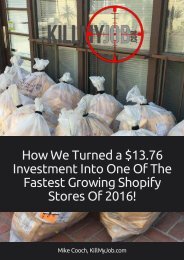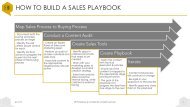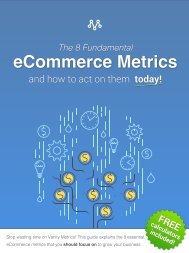You also want an ePaper? Increase the reach of your titles
YUMPU automatically turns print PDFs into web optimized ePapers that Google loves.
H O W<br />
T O<br />
F E E D<br />
T H E<br />
CONTENT<br />
BEAST<br />
(without getting eaten alive)<br />
curata<br />
SM
How to <strong>Feed</strong> the Content <strong>Beast</strong> (without getting eaten alive) © 2012 by Curata, Inc.<br />
Copyright holder is licensing this under the Creative Commons License, Attribution 3.0.<br />
Please make all attributions to curata.com.
Foreword<br />
Are You Ready?<br />
By Ann Handley<br />
I could start the foreword<br />
to this ebook with some<br />
language about the<br />
importance of<br />
interesting and valuable<br />
content as a cornerstone<br />
of your marketing. I could<br />
say something about<br />
how unless you’ve been living under a rock, you<br />
must have heard... and so on and so forth and blah<br />
blah blah.<br />
But see? Even I’m bored by that kind of<br />
introduction, and this ebook deserves something<br />
far more stylish and interesting as a kickoff.<br />
And so do you. Because you are clearly discerning,<br />
having already embraced the idea that your content<br />
is something worth paying attention to, investing<br />
in, and truly caring about. And that, to me, is the<br />
root of all good content: grokking the notion that<br />
content marketing isn’t just a box to check on a<br />
marketing plan, or a one-and-done campaign, or a<br />
template to populate with boring text and stock<br />
images. (“A blog? Yeah, we have that. Next!”)<br />
Rather, your content marketing presents a rich<br />
opportunity.<br />
To do what? To connect with your customers and<br />
prospects in a meaningful way. To tell your story in<br />
a way that is draws your customers to you. To<br />
resonate more deeply. To create something new<br />
and interesting with a set of new tools and an array<br />
of new channels. To create content that can drive<br />
real business growth and—I believe—transform<br />
your business.<br />
Does that sound all blue-sky and Kumbaya? It<br />
shouldn’t. Because that’s the real opportunity we<br />
all now have before us. Content is what will set your<br />
company apart—because it will define how you<br />
relate to your customers, and whether your<br />
customers choose you over everyone else.<br />
<strong>The</strong>se are exciting times for businesses. We have<br />
incredible opportunities with content. You have the<br />
power. You have the tools. <strong>The</strong> rest is up to you.<br />
Ann Handley is the Chief Content Officer of MarketingProfs (www.marketingprofs.com) and the coauthor<br />
of the bestselling Content Rules: How to Create Killer Blogs, Podcasts, Videos, Ebooks, Webinars<br />
(and More) That Engage Customers and Ignite Your Business.
4
Table of Contents<br />
It’s time to face your fears ....................................................................................................... 2<br />
<strong>The</strong> nature of the beast ........................................................................................................... 5<br />
<strong>The</strong> content “sandwich”........................................................................................................... 7<br />
What’s for dinner? ................................................................................................................... 11<br />
Order up! Fresh, short-form content .................................................................................. 13<br />
Cornerstone, long-form content ......................................................................................... 18<br />
Bite-sized or meal-sized – versatile formats ..................................................................... 20<br />
Finishing garnishes – because presentation matters ..................................................... 23<br />
6 tips for smart and effective content curation .............................................................. 25<br />
Still hungry? Other resources ............................................................................................... 27<br />
About Curata ............................................................................................................................ 29<br />
1
It’s time to face your fears.<br />
As a content marketer, you know the beast. You have heard its heavy footfalls hard<br />
on your heels as you struggle to crank out another volley of blog posts. You’ve felt<br />
its hot breath on the back of your neck as you frantically tried to shoe horn your<br />
latest ebook into your content development calendar. You’ve caught sight of its<br />
slavering jaws as you tossed a couple articles, a podcast, and half a dozen tweets<br />
over your shoulder, hoping to sate the creature’s rapacious appetite.<br />
<strong>The</strong> bad news: <strong>The</strong> beast is always hungry.<br />
It’s the stuff of every content marketer’s nightmares – this never-ending demand<br />
for more content. Despite all our best intentions, we never catch up. <strong>The</strong>re is not<br />
enough time, resources, or budget to get ahead of the curve. Instead of an inspired<br />
chef creating delectable dishes to delight our audience, we become short order<br />
cooks, ceaselessly churning out quick-fix meals that the beast swallows whole<br />
without so much as a thank-you-very-much.<br />
<strong>The</strong> good news: <strong>The</strong> beast<br />
is always hungry.<br />
It’s a hectic pace, to be sure, but at the end of<br />
the day, we love the beast. It runs us ragged,<br />
but it also delivers great value to our<br />
business: more traffic, improved search<br />
rankings, solid lead generation and<br />
nurturing, increased credibility – the list goes on<br />
and on. Though the beast can be a backbreaker,<br />
if we get to know it we can make it our ally. <strong>The</strong><br />
potential benefits are almost without end.<br />
2
<strong>The</strong> really good news: <strong>The</strong>re is a way to feed the<br />
beast without getting eaten alive.<br />
In this ebook, we’re going to share with you both Big Ideas and tactical tips to help<br />
you keep the content beast happily well fed.<br />
• We’ll start with a high-level overview of the content lifecycle. This will give<br />
you a sense of the beast’s natural habitat and behaviors.<br />
• Next, we’ll do a deep dive on the different types of content and how you<br />
can use both content creation and content curation to build a balanced,<br />
beast-worthy diet.<br />
• Finally, we will give you some nitty-gritty tips and resources that will put<br />
the final garnish on your efforts.<br />
At the end of the day, the only way to overcome your fears is to look them in the<br />
eye and say, “I’m not afraid of you.” This ebook will give you the courage to do just<br />
that, and – with any luck – the beast will be your new best friend.<br />
We’re all publishers now...<br />
When content became king, marketers became<br />
publishers. We shifted our focus from traditional<br />
outbound strategies to delivering the kind of<br />
content that drives successful inbound campaigns.<br />
Instead of going out and hunting prospects, we<br />
<strong>The</strong> two complementary<br />
halves of content marketing<br />
are creation and curation.<br />
had to learn how to lure them to our doorstep. High quality content, delivered<br />
consistently and through a variety of channels proved to be the best way to<br />
accomplish that goal.<br />
3
… but we have other jobs to do, too.<br />
Unfortunately, most of us don’t have the luxury of<br />
concentrating one hundred percent on our<br />
content marketing strategy and<br />
execution. In addition to feeding the<br />
content beast, we wear many other<br />
hats and have plenty of other<br />
monsters who need our attention.<br />
Solution: blending creation and curation in a<br />
perfectly balanced content diet<br />
<strong>The</strong> two complementary halves of content marketing are creation and curation. In the<br />
context of feeding the beast, you can think about it like this:<br />
CREATION: Developing original content<br />
When you author original content, you take on the role of chef.<br />
You are responsible for coming up with a unique recipe and<br />
preparing the dish. Your original content is a direct expression<br />
of your signature philosophy and style.<br />
CURATION: Collecting, filtering, organizing, and editorializing<br />
other people’s content<br />
<strong>The</strong> curation side of things encompasses a variety of roles:<br />
• Editor (aka food critic): Filtering available content, selecting the best pieces,<br />
ranking them (for relevance and quality), organizing and categorizing<br />
information to make it easier to understand and consume.<br />
4
• Journalist (aka foodie): Sharing enthusiasm for a particular topic, researching and<br />
reporting, showing all sides of a story, integrating opinion.<br />
• Analyst (aka head chef): Setting the standards, explaining the rules, providing insights<br />
from a broad perspective.<br />
Though the beast would happily dine on a diet of one hundred percent original, created content,<br />
it wouldn’t be the healthiest thing – for you or the beast. Adding curated content to the menu<br />
saves you from burn out and provides the beast with a much more balanced diet.<br />
We’ll cover creating the perfect balance, but first let’s<br />
look at the challenges of feeding the beast.<br />
<strong>The</strong> nature of the beast<br />
<strong>The</strong> beast is a ravenous creature with a high<br />
metabolism. Its appetite for content actually<br />
increases the more it consumes. Once you decide to<br />
feed the beast, you<br />
Once you decide to feed<br />
the beast, you have to<br />
keep feeding it.<br />
have to keep feeding<br />
it. If you don’t, it will<br />
find another source of<br />
sustenance – probably at your competitor’s<br />
table. To keep up with the beast’s voracious appetite you<br />
need to deliver a continuous stream of fresh, relevant<br />
content. A stale website won’t do the trick for this consumer.<br />
5
It has teeth<br />
Proper beast feeding requires courage, commitment, and the ability to provide straight<br />
answers to some challenging questions. For instance:<br />
On getting started:<br />
• What are your content marketing goals?<br />
• What are your primary and ancillary topics?<br />
• What kinds of content and media will you produce?<br />
• How will you balance focus on your own brand with a broader perspective?<br />
On producing and curating content:<br />
• How will you allocate resources, budget, and time?<br />
• How will you keep up with the daily grind, yet still make time for longer form projects?<br />
• How will you create publishing consistency?<br />
• How will you maintain the high quality of your content?<br />
On publishing and promoting your content:<br />
• What kind of approval process do you need to navigate?<br />
• How will you find and engage your audience?<br />
• How will you ensure strategic delivery at key points along today’s non-linear<br />
buyer path?<br />
• How will you measure success and ROI?<br />
Proper care and feeding requires solid strategy<br />
It is possible to keep the beast’s hunger sated, but content marketers must approach with<br />
caution – and a plan.<br />
Up next, the five-step plan for creating and managing an efficient and effective content<br />
lifecycle that will keep the beast happily munching and crunching its way towards deeper<br />
engagement with your brand.<br />
6
<strong>The</strong> content “sandwich”<br />
Your created and curated content<br />
might be the main course, but<br />
strong content marketing is always<br />
sandwiched between solid front-end<br />
and back-end strategy.<br />
Front-end strategy:<br />
from menu planning to the test kitchen<br />
Don’t guess at what the beast wants. You might get lucky, but you might miss the<br />
mark and find the beast’s attention drawn away by the savory smells coming from<br />
someone else’s kitchen. Invest in due diligence so you can offer an irresistible<br />
content smorgasbord.<br />
Step 1: Goals<br />
If you’re going to go to all the effort of feeding the content beast, you should know<br />
what you’re hoping to achieve so you can tailor the meal to meet your business<br />
goals. <strong>The</strong> content you produce and curate can be designed to achieve a wide<br />
variety of goals. For example:<br />
Increasing<br />
Improving<br />
º Site traffic º Search engine optimization (SEO)<br />
º Brand awareness and visibility º Customer service<br />
º Asset downloads<br />
º Lead generation Building<br />
º Customer trust, rapport, and loyalty<br />
Educating prospects<br />
º Industry credibility<br />
º On your industry<br />
º On your product benefits Creating community<br />
º Manage the conversation<br />
Defining your goals helps you make smart content decisions. Knowing what you<br />
hope to accomplish, you can make sure each and every piece of content moves you<br />
towards that objective.<br />
7
Step 2: Research<br />
<strong>The</strong> beast is an exotic creature. For best results, you don’t want to feed it just any old content. Figuring<br />
out the optimal diet requires some analysis of your audience, topics, and content formats:<br />
Audience:<br />
• Who are they?<br />
• Where do they look for content?<br />
• What keeps them up at night?<br />
Topics:<br />
• What do you want to be known for?<br />
• Who is driving topic trends in your<br />
industry?<br />
• Where are people getting information<br />
on your topic now?<br />
Formats:<br />
• What...<br />
º Types of media<br />
º Content mix (created vs. curated; branded<br />
vs. non-branded)<br />
• How...<br />
º frequently will you publish?<br />
º will you deliver content (publishing and<br />
promoting)?<br />
º will you engage your audience?<br />
Step 3: Testing<br />
Don’t fall into the rut of serving the “same-old same-old” day after day. Change it up, spice it up, dress it<br />
up. Common elements and factors to test include:<br />
• Topics<br />
• Headlines (content and presentation (font size, placement, etc.))<br />
• Offers/calls to action<br />
• Tone of voice/brand personality<br />
• Design (layout, graphic assets, colors, etc.)<br />
• Media types (text, audio, graphics, video, webinars, etc.)<br />
• Frequency of contact (daily, weekly, monthly, quarterly)<br />
• Promotion platforms (email, Twitter, Facebook, LinkedIn, etc.)<br />
• Engagement tools (commenting platforms, social sharing, live chats, etc.)<br />
It will take a little experimentation to determine the types of content dishes the beast likes best, and<br />
which ones help you best meet your content marketing goals. Get creative with the ingredients at your<br />
disposal. You’ll eventually discover your secret sauce.<br />
8
Back-end strategy: discovering your<br />
secret sauce and loving leftovers<br />
<strong>The</strong> other half of your content sandwich is everything<br />
that happens on the back-end of the content lifecycle.<br />
You’ve done your research and planning. You’ve<br />
created an inspired content banquet for the beast.<br />
Now, it’s time to hear the reviews, tweak your<br />
recipes, and extend the life of your content so<br />
nothing goes to waste.<br />
Step 4: Measuring and Optimizing<br />
Pay attention to patterns in the beast’s preferences. Notice when it comes back for seconds<br />
or shares rave reviews about your content. Keep track of your wins and your failures.<br />
In addition to monitoring organic feedback, don’t be shy about asking for direct feedback.<br />
A satisfaction survey can provide valuable insights into what makes the beast’s mouth water.<br />
Also be sure to stay on top of what the competition is serving. Compare and contrast your<br />
offerings to identify your content strengths, weaknesses, opportunities, and threats.<br />
As you see consumption peaks and trends, you can start to get a sense of your secret sauce;<br />
the thing you do better than anyone else. This is what gives your content a little something –<br />
something that the beast can’t resist. Optimize, iterate, and test to find the signature dish<br />
that will always bring the beast back for another helping.<br />
9
Step 5: Repurposing<br />
A hungry beast can quickly eat you<br />
out of house and home. Creatively<br />
reinventing your original content<br />
by delivering it in multiple formats<br />
ensures that you get the most value<br />
out of everything you produce.<br />
Don’t worry about boring the beast.<br />
<strong>The</strong>re are many reasons why<br />
repurposing created content is a<br />
smart and efficient strategy:<br />
• Media preferences: Some<br />
people prefer text, some<br />
audio, some video. Some<br />
would rather have their<br />
content delivered as an<br />
infographic. Mix it up to<br />
reach more of your audience.<br />
<strong>The</strong> opportunities for content repurposing<br />
are almost limitless. For instance:<br />
• Turn an ebook into a series of blog posts, or a series<br />
of blog posts into an ebook.<br />
• Create a transcript so content “snackers” can scan<br />
the information from a webinar.<br />
• Capture a real-time tweet chat and republish it as a<br />
crowd-sourced blog post.<br />
• Pull sound bytes out of a long-form report and use<br />
them as tweets and Facebook updates.<br />
• Give quotes a new life as graphics for use on visual<br />
platforms like Facebook and Pinterest.<br />
• Audience “appetite”: One person might be willing to invest thirty minutes<br />
watching a detailed webinar, someone else might only be willing to scan the<br />
headlines in a summary blog post. Give your audience options.<br />
• Audience attention: Your audience is not always tuned in. Repetition helps you<br />
reach more of your audience more consistently. It may feel like you’re serving up<br />
the same dinner over and over, but to them it’s the special of the day.<br />
Keep the beast’s appetite from bankrupting your marketing budget by finding ways to<br />
mix repurposed favorites in with the daily specials.<br />
Speaking of... it’s time to swap content recipes.<br />
10
1. Fresh, short-form content<br />
What’s for dinner?<br />
You’ve set your marketing goals and done your research about<br />
what the beast wants. It’s time to get busy in the content kitchen.<br />
Depending on your goals, resources, and style, there are three<br />
main types of content you can serve:<br />
This is the everyday fare that keeps the beast happy from meal-to-meal. It includes things like<br />
blog posts, newsletters, and your social media content. You need<br />
to generate an on-going stream of this content to keep the<br />
beast engaged.<br />
2. Cornerstone, long-form content<br />
Every once in a while, you want to serve up<br />
something extra special. Like a holiday meal, longer<br />
form pieces like ebooks, special reports, and<br />
infographics give you the chance to demonstrate<br />
your in-depth knowledge and expertise.<br />
3. Crossover content<br />
<strong>The</strong>n there are versatile content formats that can be served up as a short-form appetizer or a<br />
long-form meal. For example, surveys, video, and webinars can each be produced quickly and<br />
served up in bite-sized bits, or be developed into lavish and filling content meals.<br />
11
CRITICAL POINT: Don’t be a diva chef<br />
<strong>The</strong>re are chefs who think it’s all about them and their culinary artistry. <strong>The</strong>y don’t<br />
pay attention to what their customers want or tolerate any other chefs in their<br />
kitchens. All they care about is creating their next big masterpiece.<br />
Don’t make that mistake.<br />
Your content should never be all about you. Striking a balance between content<br />
creation and content curation is the best way to deliver a balanced diet for the<br />
beast. Your table should offer a wide variety of content – yours and others’ - for the<br />
beast’s dining pleasure.<br />
Including curation in your content strategy is also good for you. In addition to<br />
delivering all the SEO, lead generation, and lead nurturing benefits of content<br />
creation, curation helps you:<br />
• Lighten the load on your resources<br />
• Reduce your content marketing costs<br />
• Provide you with an endless supply of content ideas and sources<br />
• Keep you on top of all the important news on your topic<br />
• Diversify your perspective<br />
(For more reasons why content curation is a super smart content marketing<br />
strategy, read our ebook, <strong>The</strong> Open and Shut Case for Content Curation<br />
available on www.curata.com.)<br />
12
Order up! Fresh, short-form content<br />
<strong>The</strong>re’s no question that consistency is critical to successful content marketing. <strong>The</strong> beast is always hungry.<br />
If you’re not satisfying that hunger, someone else will. But, it’s tough to keep up with the grind of daily<br />
content production. <strong>The</strong> solution is a smart, balanced strategy that supplements your original content with<br />
curated content.<br />
Let’s take a look at a few ways to create and curate four popular types of fresh, short-form content:<br />
Blog posts<br />
CREATE:<br />
• Original posts provide your thoughts and opinions on relevant topics, news, and events.<br />
• Interviews with clients, industry experts, or employees give you a chance to showcase your<br />
expertise and your connections.<br />
• Guest posts – both outgoing (your original content hosted on someone else’s<br />
blog) and incoming (original content sourced from a third party) are a great way<br />
to build your network and your audience.<br />
CURATE:<br />
• “Wrap-up” posts, where you pull together a collection of other people’s posts,<br />
are a great way to provide a broad overview of what’s going on while positioning<br />
yourself as an expert and creating connections to your industry peers (who are usually happy to<br />
have their work featured).<br />
• Crowd-sourced posts are a quick and easy way to generate interesting, multi-faceted content<br />
featuring the curated comments of others. Pose a single question to a group of peers or clients and<br />
publish the responses in a blog post. Or, host a tweet chat and share the best tweets on your blog.<br />
• Event summary posts that include a collection of key quotes from speakers, event-related tweets,<br />
video clips, slides, photos, and/or links to related content are a valuable resource for both event<br />
attendees and folks who weren’t able to be there in person.<br />
• Reblog posts from other bloggers. Publish a short excerpt or an abstract from someone else’s blog<br />
and provide a link back to the original source so your subscribers can read the full text.<br />
13
News Sites<br />
CREATE:<br />
• Resource sites and news portals are typically very popular<br />
destinations within any vertical, but producing one that<br />
contains all original content is something that is way out of reach for most marketing<br />
departments. Only the biggest players in journalism have the resources to maintain<br />
such sites, and that’s because it’s their full-time job.<br />
CURATE:<br />
• Instead of publishing only in-house content, most marketing news sites deliver a<br />
mixture of original and curated stories. This provides readers with a broader<br />
perspective, and it is a much more manageable model for most marketing teams.<br />
Here are a few examples of curated news sites that also feature original content:<br />
º Carrier Ethernet News by Overture Networks - www.carrierethernetnews.com-<br />
“... primary source of up to the minute news and expert commentary relating<br />
to Carrier Ethernet... the foundation for all wireline and wireless services and<br />
networks.”<br />
º iQ by Intel - iq.intel.com - “... is an intelligent system that curates content<br />
shared by leading thinkers, engineers and scientists at Intel.”<br />
º Green Data Center News by VerneGlobal - www.greendatacenternews.org -<br />
“... not-for-profit website dedicated to providing the latest news about Green<br />
Data Centers.”<br />
º threatpost - the Kaspersky Lab Security News Service by Kaspersky -<br />
threatpost.com/en_us- “... an independent news site which is a leading source<br />
of information about IT and business security... important original stories...<br />
expert commentary on high-priority news aggregated from other sources...”<br />
14
Newsletters<br />
CREATE:<br />
• Supplemental content that goes above and beyond what’s on your blog incentivizes<br />
readers to become subscribers for the “200-level” information.<br />
• Event-related content such as invites, updates, on-the-scene reports, and so on help<br />
keep your audience tuned into what’s happening with your events.<br />
• Behind-the-scenes content gives readers a closer look at why and how you do what<br />
you do and can help build interest and rapport.<br />
• Announcements about new services, site content, specials, and so forth make great<br />
newsletter content because they offer an immediate value.<br />
• Conversation starters encourage intimacy and can provide a<br />
valuable source of direct audience feedback via email exchange.<br />
Chris Brogan uses this technique to dig deeper into his<br />
audience’s interests and needs.<br />
@<br />
CURATE:<br />
• Curate your own content to provide a handy index for a particular time period or a<br />
specific topic. This is also a great way to give older content a new lease on life.<br />
• Week-in-Review newsletters provide subscribers with an overview of what’s been<br />
happening not only with your brand, but around your industry. Like wrap-up blog<br />
posts, these review newsletters establish your brand as a thought leader because you<br />
decide what’s worth sharing and provide your opinions on those stories.<br />
• Hybrid curated newsletters combine links to original and third-party content. Using<br />
this model, you can highlight your best content within the context of the larger,<br />
industry conversation – again, positioning yourself as a leader who is tuned into<br />
what’s going on.<br />
15
Social Media<br />
CREATE:<br />
• Links to original content allow you to promote your created content<br />
across your social networks.<br />
• Announcements about your online and offline events help you drive<br />
participation, coverage, and buzz.<br />
• “Quotables” are becoming more and more popular, especially on<br />
visual platforms like Pinterest and Tumblr (and, with the Timeline update, Facebook). Graphically<br />
presented sound bytes are easily shared across networks and platforms, increasing the chance<br />
for content to go “viral.”<br />
• Images in general have wide appeal on social sites. Sharing original images from your office,<br />
clients, and events is a quick and easy way to generate appetizing content.<br />
• Conversations are an important part of your social media content. Whether they take place in<br />
the context of your own posts, or in response to someone else’s content, the dialog you create<br />
with your audience is an important reflection of your brand and a valuable chance to make a<br />
lasting impression – one customer at a time.<br />
CURATE:<br />
• Likes, shares, RTs, repins, reblogs, and... the truth is that a BIG part of social media is nothing but<br />
pure curation. A brand that uses social only to promote its own content will quickly be labeled<br />
“boring,” “self-centered,” or (gasp!) a spammer. Instead, build mutually beneficial relationships<br />
by promoting other people’s content. Providing a valuable stream of well-curated “picks” from<br />
the social stream will help you deliver value, build your audience, and increase your credibility.<br />
• Third-party content that you introduce into the social stream is an equally powerful tactic that<br />
helps you become the go-to guru on your topic. Introducing freshly curated content helps<br />
people discover new ideas, resources, and voices. Curation puts you at the center of those<br />
connections, elevating your brand to a leadership role.<br />
If you’re interested in learning more about the power of social sharing and dialog, the book<br />
Groundswell – Living in a World Transformed by Social Technologies by Charlene Li and<br />
Josh Bernoff is a great read that includes a variety of case studies and strategies.<br />
16
Podcasts<br />
CREATE:<br />
• How-to podcasts that focus on tasks relevant to your topic are a<br />
great way to showcase your in-depth know-how.<br />
• Interview-based podcasts allow for natural and engaging dialog<br />
between host and guest. As the “author,” you can choose the<br />
topics and guide the conversation to highlight key points you<br />
want to make.<br />
• Audio blog podcasts are simply spoken blogs. <strong>The</strong>y include the same, original content as<br />
you might include in a feature blog post, but in an audio format that will appeal to the<br />
non-reader segment of your audience.<br />
CURATE:<br />
• Panels bring together a collection of viewpoints and expertise for your audience. As the<br />
host and facilitator, you add value for your listeners by choosing the topic, the speakers,<br />
and directing the exchange of ideas.<br />
• Newscast podcasts are the audio equivalent of the wrap-up blog post or week-in-review<br />
newsletter. <strong>The</strong>y give you the opportunity to present the most important developments<br />
related to your topic, and add your two cents via editorial commentary.<br />
If you’re interested in learning more about launching your own podcast, Jon Buscall of Jontus<br />
Media has written the ebook on the topic: Launch a Podcast - jontusmedia.com/launch-podcast/<br />
17
Cornerstone, long-form content<br />
Though your daily delivery of fresh, short-form content will<br />
keep the beast happily munching away, it’s nice to prepare<br />
something extra special once in a while. Long-form<br />
content gives the beast something more substantial to<br />
chew on. It gives you the chance to dig deep on a key<br />
topic or idea – showcasing your exceptional skills.<br />
Long-form content is often, but not always, “evergreen” –<br />
meaning it won’t have an expiration date. Evergreen pieces can<br />
become a strong cornerstone of your content marketing strategy. It’s the<br />
signature dish that inspires the rest of your menu.<br />
Here are three examples of long-form content and some<br />
ideas on how you can create and curate your way to a<br />
content meal that will make the beast drool:<br />
Ebooks:<br />
CREATE:<br />
Long-form content gives<br />
the beast something more<br />
substantial to chew on.<br />
• Best practices are probably the most popular ebook topic because they position you<br />
as an authority who knows how things should get done.<br />
• How-to topics also have broad appeal and help you educate your audience at a<br />
deeper, more hands-on level.<br />
• Proprietary processes make for useful ebook content because they help familiarize<br />
your audience with the specifics of engaging with your product or service. <strong>The</strong>y can<br />
become long-term reference for your audience and reduce the drain on your<br />
customer service and technical resources.<br />
• Experience-based ebooks are another way to share original, proprietary content.<br />
Examples include extended or collected case studies that demonstrate your solution’s<br />
effectiveness, and behind-the-scenes stories that help build brand affinity.<br />
18
CURATE:<br />
• Curated collections of quotes, anecdotes, or opinions have a strong track record of<br />
success with audiences who are pressed for time. <strong>The</strong> “quick-read” nature of these<br />
ebooks makes them particularly appealing to and effective for customers who like the<br />
concept of the “big ebook meal,” but can’t consume the whole thing in one sitting.<br />
Here is a sampling of ebooks in which brands have put the content of others to<br />
good use:<br />
º HubSpot’s popular 101 Awesome Marketing Quotes is a collection of<br />
inspiring and thought-provoking quotes from a variety of sources.<br />
º Dianna Huff’s Top 10 B2B Marketing Mistakes... And How to Avoid <strong>The</strong>m<br />
curates the insights of thirty-four well-respected marketers.<br />
º <strong>The</strong> “Savvy Sisters” curated a collection of quotes from their own archive of<br />
blog posts to create 60 Savvy B2B Marketing Inspirations, a visual/sound byte<br />
overview of three years of insights on B2B marketing.<br />
Special Reports:<br />
Although they may draw on a variety of references and resources, special reports are typically<br />
considered original content. Usually based on proprietary research and data, special reports<br />
provide a “state of the union” overview of industry developments and trends.<br />
In cases where budget or resources cannot support proprietary research, curated content can<br />
be the basis for a special report. Wearing both the journalist and analyst hats, you can curate<br />
key pieces of third-party data to help your audience make sense of a complex story.<br />
Infographics:<br />
Similarly, infographics can be either created or curated. By definition, an infographic is an<br />
organized collection of disparate observations and data points, presented in a graphic<br />
format. Whether the infographic is created or curated depends on the source of the data.<br />
19
Bite-sized or meal-sized – versatile formats<br />
<strong>The</strong>re are a number of content formats that you can use in multiple ways. If the beast<br />
just needs a quick snack, you can create “quickie” pieces of content. If the beast has<br />
a serious tummy rumble, these same formats can be developed into robust content<br />
pieces that will sate even the beast’s legendary appetite... at least for a little while.<br />
Polls and Surveys:<br />
CREATE:<br />
• For something that will fill the beast’s belly, set up an original, multi-question<br />
survey and collect responses over a set period of time. This created content<br />
often becomes the foundation for other long-form content like special<br />
reports and custom charts and graphics.<br />
CURATE:<br />
• But, if you just want to serve up a quick<br />
snack, many social platforms offer an<br />
efficient environment for running quick<br />
opinion polls and surveys. Pose a question<br />
Some content formats<br />
can fit the bill whether it’s<br />
snack-time or meal-time.<br />
to your Twitter followers or on sites like Quora and FOCUS. Create mini polls on<br />
Facebook or LinkedIn. Curated responses from these “real time” queries can be<br />
repurposed as a blog post or expanded social media content.<br />
20
Video:<br />
CREATE:<br />
• Original video can serve as either an appetizer or a meal<br />
depending upon the complexity of the topic, run time of the<br />
piece, and the quantity and quality of resources allocated to<br />
production. On the one hand, you might crank out a series of 60-second videos<br />
that require very little investment in terms of budget or manpower. On the other<br />
hand, you might assign a high-level team to concept and craft a longer, more<br />
professional video.<br />
• You might produce individual videos, or invest longer term efforts into creating a<br />
cohesive series.<br />
• You can create your own YouTube channel to showcase all your existing video<br />
content in one place.<br />
CURATE:<br />
• Curating user-generated video collections is a tactic that has worked well<br />
for both consumer and B2B brands. For example, Big Apple Circus<br />
(videos.bigapplecircus.org) uses this strategy to share videos from third-party<br />
and user-generated sites to deliver diverse and unbiased content. A number of<br />
new platforms have launched to help content marketers curate a video banquet:<br />
Visible Gains, Brightcove, and Magnify are just a few.<br />
• You can also curate video one clip at a time – sharing relevant videos via your<br />
blog or social media channels.<br />
21
Webinars:<br />
CREATE:<br />
• A webinar can be as simple as a brief, single-topic event with minimal structure and visuals, or<br />
as complex as a highly strategic and scripted presentation that includes professional design,<br />
multiple speakers, and interactive components. Whichever end of the scale you’re on,<br />
original content - often proprietary or product-specific - will be the focus.<br />
CURATE:<br />
• On the curated side, there are abundant opportunities to pull together and contextualize a<br />
wide variety of ideas and examples to teach your audience about broader, brand-agnostic<br />
topics. Including curated case studies, opinions, and data in your educational webinars helps<br />
you make your point more succinctly and clearly while positioning you as an expert with a<br />
vast knowledge of your topic.<br />
• In addition, you can also curate collections of webinars for your audience - providing a<br />
centralized repository for the most relevant and helpful presentations (along with your<br />
reviews, of course.)<br />
Don’t forget about graphic content<br />
With so many social platforms focusing on<br />
visual content (Pinterest, and now<br />
Facebook’s Timeline update, for instance),<br />
it’s to your advantage to find ways to<br />
transform your content into graphic formats.<br />
Presenting sound byte quotes as images can<br />
help your content “pop” in the busy feeds<br />
of these visual sites. Or, you can take a more<br />
in-depth approach like global shipping<br />
company Maersk. <strong>The</strong>y used strong visuals<br />
to build their Facebook following to nearly a<br />
quarter million in just five months and also<br />
use Instagram and Pinterest to showcase the<br />
breadth and reach of their company. In<br />
addition to posting their own images, they<br />
curate customer images as well. (For more<br />
details, check out Jay Baer’s in-depth<br />
interview with Maersk’s head of social media,<br />
Jonathan Wichmann, on the Convince and<br />
Convert Social Pros podcast.)<br />
22
Finishing garnishes – because<br />
presentation matters<br />
Despite its unquenchable appetite, the beast is quite discerning in its tastes.<br />
Whether you’re creating or curating content, it’s important to pay attention to<br />
the details. Here are some tips to help you make the right impression.<br />
Three universal content creation concepts<br />
No matter what format you’re working in (text, audio, video), or scale (quick-turn content<br />
appetizers, or long-form content projects) keep these concepts firmly in mind to increase<br />
your content’s table-side appeal:<br />
1. WIIFM Mindset: More than anything else, your audience wants to know “what’s<br />
in it for me.” If you maintain focus on this, you will always capture the beast’s<br />
attention.<br />
2. Style: Personality, voice, and presence – all of these things go into your content<br />
style. Think about the persona you want to project. Do you want to be seen as<br />
approachable, helpful, knowledgeable, experienced, fun? Find the style that fits<br />
your brand essence and then deliver it consistently.<br />
3. Idea Organization: Whether you’re speaking to a live audience, writing a blog<br />
post, or preparing a webinar, use these organizational tips to deliver content that<br />
is clear, helpful, and engaging:<br />
º Strong headlines – Craft a headline that is relevant, helpful, and conveys a<br />
sense of urgency, exclusivity, or both. Bonus points if it’s also entertaining.<br />
23
º Focused outline – Think about the most important points you need to<br />
make to deliver on the WIIFM promise. Keep yourself on track by creating<br />
a simple outline. Don’t deliver too many ideas at once. Keep it simple. If<br />
it starts to feel too heavy, break it down into multiple pieces of content.<br />
º Scannable content – For text-based content use subheads, bullets,<br />
bolded words, and standalone lines of text to provide scanning anchors<br />
for your readers. For audio and video content, include a written<br />
summary.<br />
º Shareable sound bytes – To streamline the social promotion of your<br />
content, integrate phrases and subheads that are well-suited for use as<br />
tweets, Facebook updates, etc. Call these out and offer one-click ways<br />
for readers to share via their social profiles.<br />
Additional content creation resources<br />
If you’re crafting your own copy, there are a<br />
number of resources that you might find helpful:<br />
• Men With Pens, menwithpens.ca<br />
• Copyblogger, www.copyblogger.com<br />
• Zen Copy’s Ultimate Guide to Writing Online,<br />
zencopy.com<br />
24
6 TIPS<br />
for smart and effective content curation<br />
1<br />
2<br />
Be strategic about your topic selection. Do the legwork to<br />
determine audience needs. Think about the voice you want for your brand.<br />
Build your content around that.<br />
Vary your sources. Exposure to a broad variety of voices, ideas, and<br />
information is one of the key values of a strong curation strategy.<br />
3<br />
Be selective. Curation is not about sharing as much as you can. It’s about<br />
sharing the best of the best – acting as a filter for your audience.<br />
4<br />
Organize based on audience needs. Make sure that you present your curated<br />
content using categorization and hierarchy that’s as useful to your audience<br />
as it is to you.<br />
5<br />
6<br />
Adhere to ethical best practices. Always attribute your original sources and<br />
only publish abstracts and excerpts.<br />
Add value. Help your audience get the most out of your curated content by<br />
providing insights, opinions, and context.<br />
25
May we suggest a stellar piece of equipment<br />
for your content marketing kitchen?<br />
As the team behind Curata, we think that it’s the best content curation software<br />
for marketers. It is the only content marketing platform that combines curation,<br />
creation, and distribution in one easy-to-use solution. Set-up is so simple you can<br />
be up and running in a few hours, and our enthusiastic and knowledgeable<br />
training and customer service staff are always on-hand to ensure the success of<br />
your content marketing efforts.<br />
Visit curata.com to get your free, 30-day trial and you can test drive the platform,<br />
get to know our team, and see the results for yourself.<br />
26
Still hungry?<br />
Never fear. We have a great collection of additional resources.<br />
Take a look and you’ll be cooking with gas in no time.<br />
Our other ebooks about the power of<br />
curation in content marketing:<br />
For more “what” and<br />
“why,” download our<br />
e-book Taming the<br />
Flood.<br />
For more “how,” check<br />
out 5 Simple Steps to<br />
Becoming a Content<br />
Curation Rockstar.<br />
For the kind of “why” that<br />
will convince your boss<br />
curation is a good idea:<br />
<strong>The</strong> Open and Shut Case<br />
for Content Curation.<br />
You can also visit our Resources page on curata.com for links to informative webinars,<br />
presentations, special reports, and more.<br />
27
And here are a few other great content marketing chefs we recommend:<br />
Content Rules by Ann Handley and C.C. Chapman<br />
www.contentrulesbook.com<br />
<strong>The</strong> book Content Rules demystifies the idea of organizations as publishers. It streamlines the<br />
process of creating remarkable content - walking you through the fundamentals of how to<br />
create bold stories, videos, and blog posts. And then it tells you how to share it to cultivate fans,<br />
arouse passion for your products or services, and ignite your business. Grab a cup of something<br />
and settle in for a great read.<br />
Content Marketing Institute (CMI)<br />
www.contentmarketinginstitute.com<br />
<strong>The</strong> brainchild of Joe Pulizzi, the original content marketing evangelist, this website serves up<br />
a veritable feast of educational blog posts, videos, webinars, and more - all on the subject of<br />
content marketing. Prepare to be inspired.<br />
MarketingProfs<br />
www.marketingprofs.com<br />
Another great resource site, MarketingProfs covers a broad variety of topics in addition to<br />
content marketing. This extensive and experienced team delivers a savory selection of articles,<br />
newsletters, seminars, podcasts, and more. Whatever marketing recipe you’re looking for, you’ll<br />
find it here.<br />
28
curata<br />
SM<br />
About Curata<br />
Curata provides easy-to-use marketing solutions for content curation and content<br />
marketing. Curata, allows marketers to quickly find, organize, and share content<br />
on specific issues or topics in order to establish thought leadership, own industry<br />
conversations and drive qualified web traffic. Curata was founded in 2007 and is<br />
headquartered in Cambridge, Mass.<br />
For more information, visit curata.com and get a FREE 30-day trial.<br />
29
How to <strong>Feed</strong> the Content <strong>Beast</strong> (without getting eaten alive) © 2012 by Curata, Inc.<br />
Copyright holder is licensing this under the Creative Commons License, Attribution 3.0.<br />
Please make all attributions to curata.com.


